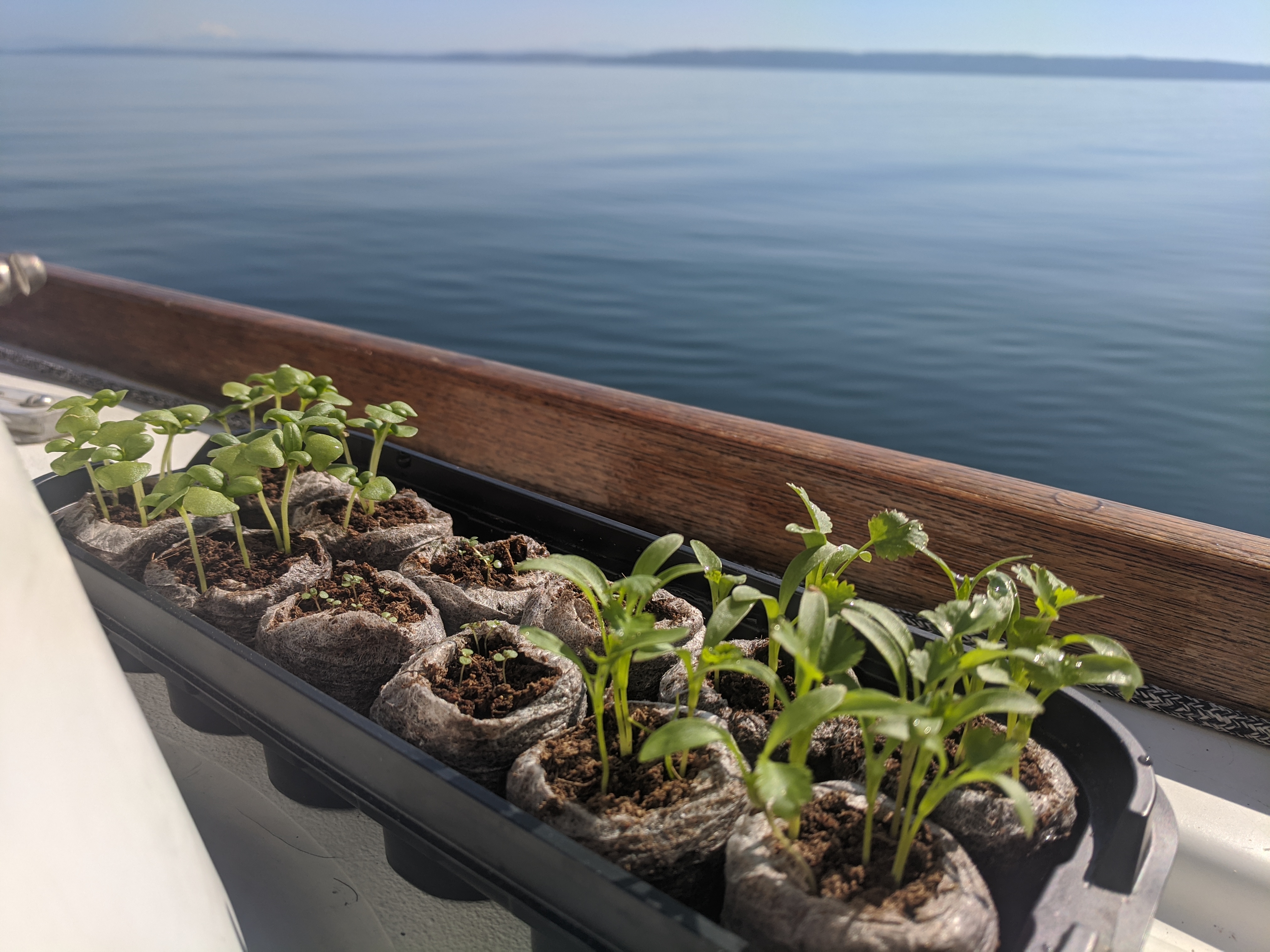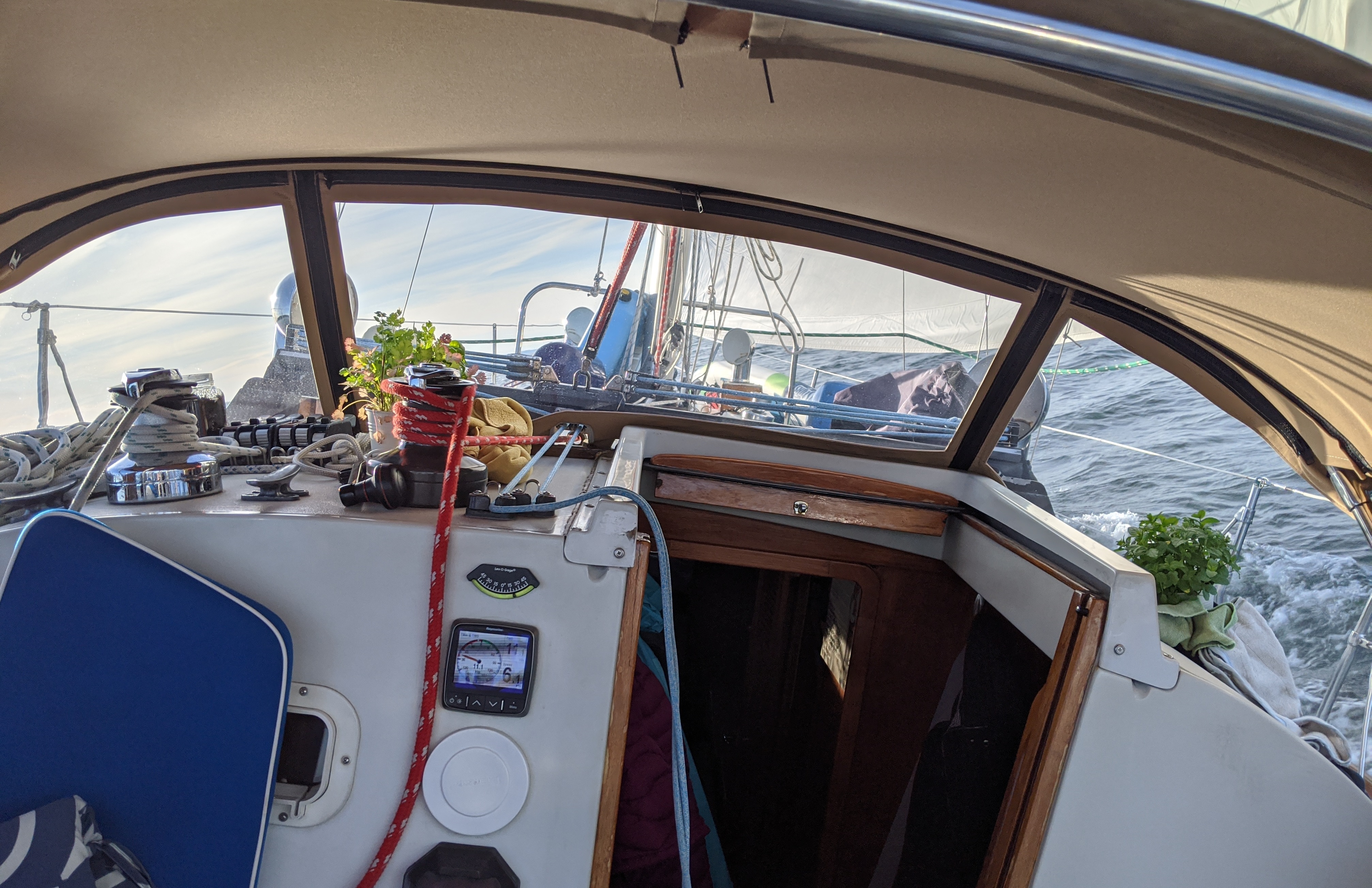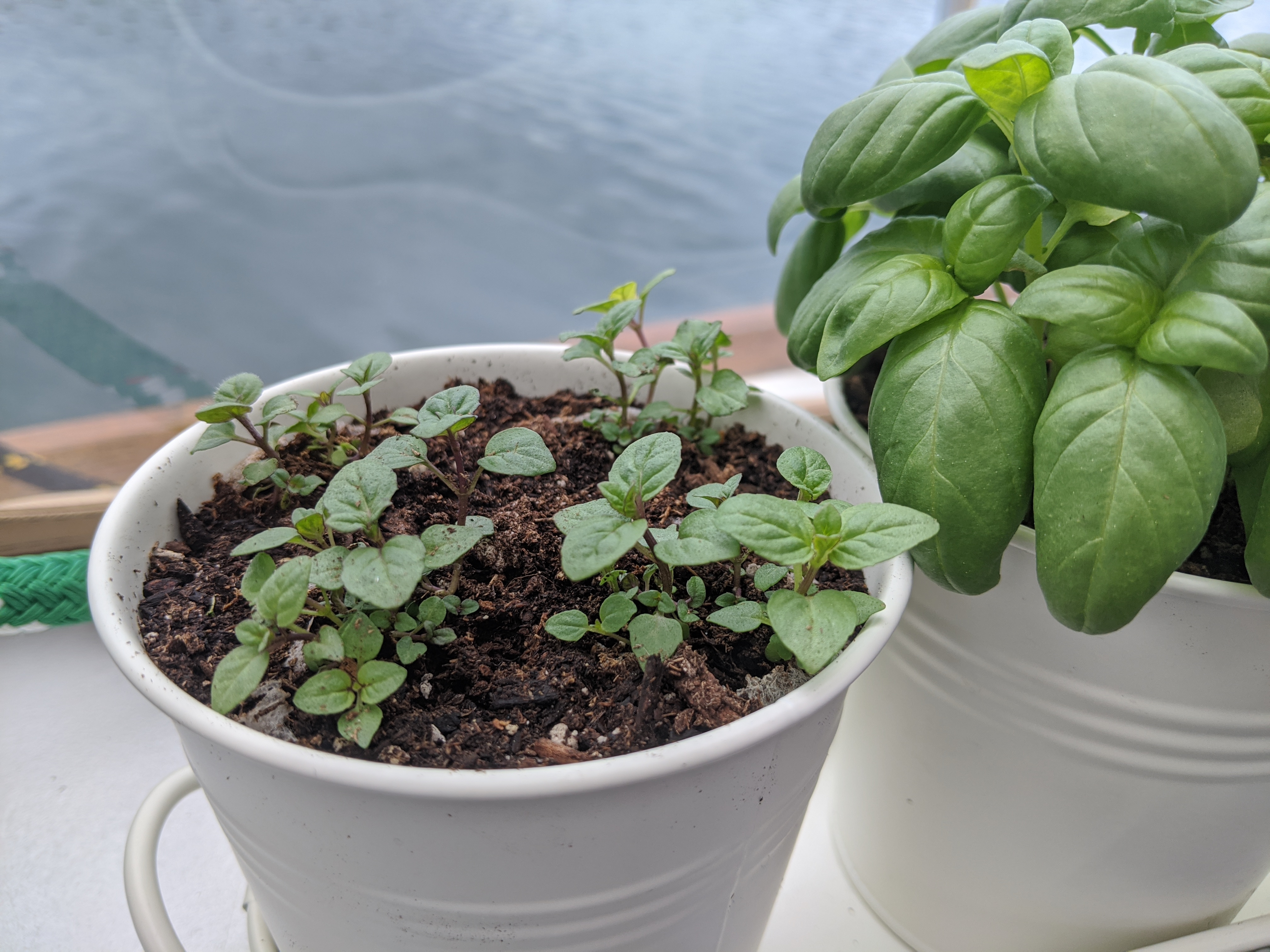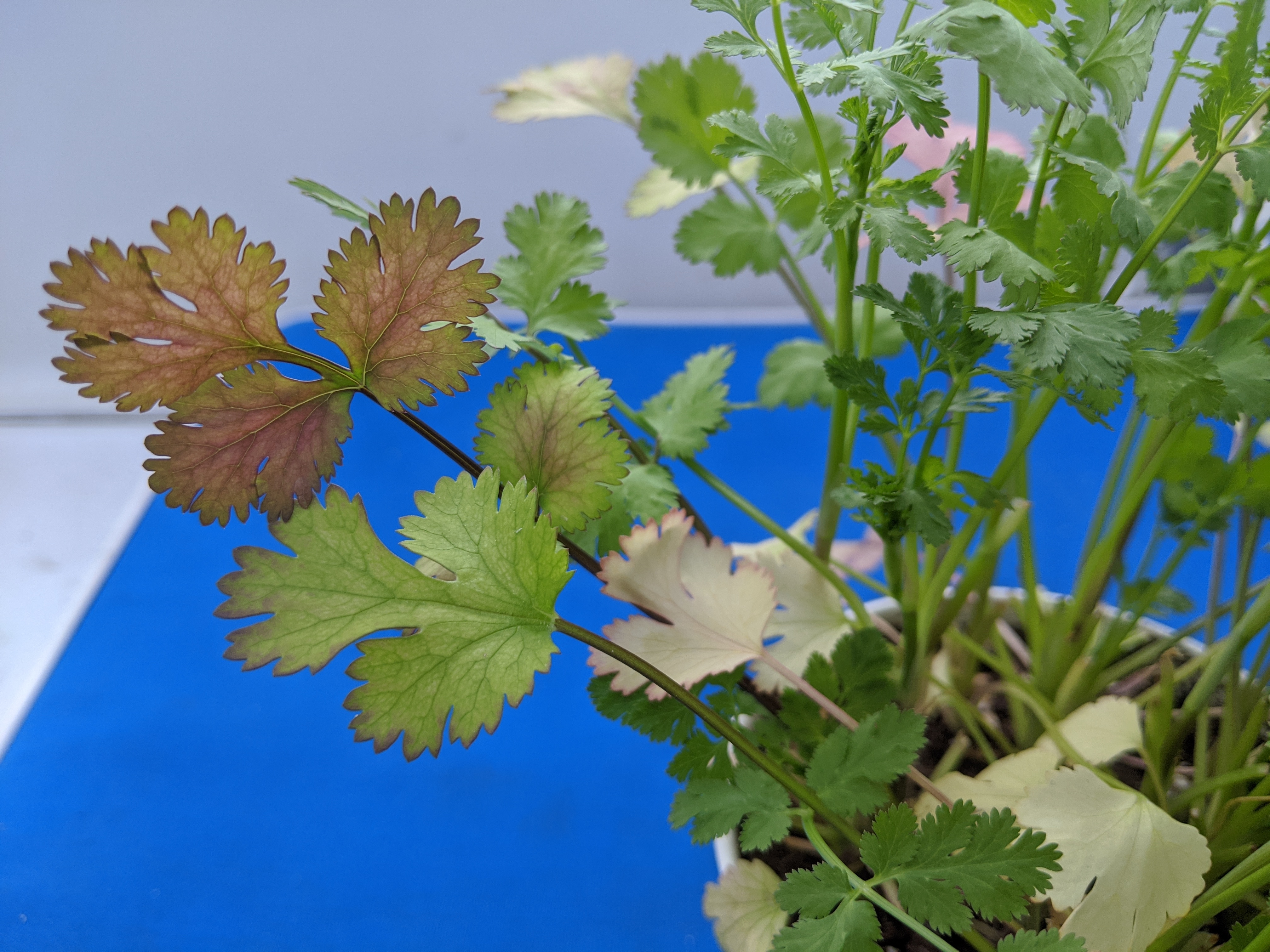We’ve been meaning to try growing herbs on our sailboat for a while now, and with the coronavirus pandemic sending us into full-on social distancing mode in March, this year was the perfect opportunity. We knew we might not be able to get groceries as often, and keeping store-bought herbs fresh for more than a week or so is very difficult on a boat anyway.
In past years we’ve bought some pretty sad cilantro in remote areas of British Columbia – by the time it makes it to the grocery store it’s spent weeks on trucks and boats, getting less fresh by the day, so it’s no surprise that it doesn’t last that long after we buy it.
With some planted herbs, we could harvest what we needed whenever we needed it. We chose to go with cilantro, basil, and mint. Cilantro is one of our most used herbs since we make Mexican food a lot (tacos, quesadillas, guacamole, enchiladas). Basil and mint were chosen because they’re easy to grow and don’t need much space or a large pot.
Other herbs or plants could be grown onboard too. For example, rosemary is easy to grow, but almost every roadside on islands in Puget Sound and the San Juans has that already, and we don’t typically use a lot of rosemary. Lettuce or tomatoes might be nice, but they require a lot of space and don’t produce very quickly.
There are a few unique challenges to overcome with growing plants on a sailboat:
- Sunlight – Sun can be rare at times in the Pacific Northwest spring, and a sailboat is constantly moving (spinning at anchor, or while sailing) so it can be challenging to keep the plants in the couple hours of sun we get some days in April and May. Many things can block the sun – our dodger, sails, mast, boom, etc. So until the plants got mature I usually moved them around to prime sun locations during the day when we were at anchor.
- Movement – our boat heels to 15-20 degrees going upwind (and we’re upwind a lot) – close to toerail in the water but not quite. So it’s important to be able to secure the plants so they don’t tip over and spill out dirt (which happened once while crossing Rosario Strait tide rips!).Our cabin top below the dodger was the best place to do this, but we could also stow them inside if we expected things to get really rough.
- Saltwater – Salt is death to plants, so it’s important to make sure no wave spray hits them. Our dodger is very watertight so this worked well for that purpose.

The seeds were started indoors in peat moss pods and then moved outdoors
Planter and Location
I bought this set of 3 pots with a tray from Amazon:
- Barnyard Designs Herb Planter Set
- Or you could try this galvanized metal set: WH Farmhouse 3-planter tray
While you can make your own from repurposed food containers or mason jars, this was handy because the tray helped contain the pots and prevent them from tipping over. They wouldn’t jump out of the tray unless sailing conditions got really bumpy.
And the tray could be prevented from sliding around by wedging it between some control lines under our dodger – between our traveler sheets and the clutches for the halyards. If necessary I could tie cords onto the handles at each end to secure it more.
The dodger seemed like the best location because it acted as a mini greenhouse – it heats up when the sun is out, and I usually could find a spot under it that had some direct sunlight. It also protected them from salt spray.

Cilantro
Cilantro is our favorite herb and therefore the one we were the most excited about. It germinates easily in 1-2 weeks, and grows quickly (harvestable within 4 weeks). But one problem we discovered is it goes to seed quickly too, and when that happens it stops producing the tasty cilantro leaves. It puts all its energy into producing the coriander seeds, which aren’t always worth the effort to grow fresh (it would only produce a very small number, so it’s easier to buy dried coriander in the grocery store).
The trick many people online recommend is to grow multiple batches of cilantro, staged about 2-4 weeks apart. Our first cilantro pot went to seed after only about 2-3 weeks of producing harvestable cilantro leaves. The many sunny days we had in late May might have caused that.
Surprisingly, our second cilantro pot went to seed almost immediately upon producing leaves! I’m not sure what caused it to do that, but perhaps it was the 16 hours of daylight we get in June (even though many days this June were cloudy and rainy). We also used different soil on this batch (half of it was from Kala Point near Port Townsend) so it’s possible that has something to do with it.
Basil
Basil goes great with mozzarella as an appetizer, in a salad, on pizza, or made into a tomato-basil salsa topping on grilled fish.
There’s a specific way to prune / harvest your basil to keep the plant bushy (growing more leaves rather than bolting upwards in height). It’s not hard – see this YouTube:
Our basil leaves are a little smaller than the big plants you see in Trader Joe’s – probably due to being root-bound in the small pot. This is no problem though since they have good flavor and produce many small leaves rather than a smaller number of big leaves.
Mint
We got spearmint, which were the only seeds we could find at the Home Depot. We realized later this isn’t our preferred type – it’s not what mojitos are typically made with. But it’s still good, and very easy to grow.
Mint takes a long time to get started however – the seeds need some sun (just sprinkle on the surface of the soil) and they took about 2-4 weeks to germinate, and nearly 2 months overall to have a plant big enough to harvest some. But now that we’re 3 months in we have way more mint than we need.

As with the basil, the leaves are a little smaller than they would be in a larger pot or outdoor garden – the small pot is constraining their root base and I planted a few too many seeds probably (a bit over a dozen in a 4” pot).
Looking Forward
We’ll probably keep growing an herb garden onboard every year. It was an easy and fun project, getting to watch the seedlings make progress day-to-day. We’re not sure we’ll grow cilantro again though, since if it continues going to seed so quickly then it’s a lot of effort for little return. Does anyone know how to slow down cilantro from going to seed?

When the cilantro starts going to seed, some leaves start turning brown/red. Take note of the dark green, frilly leaves towards the stalk tops – those are the start of seed pods.


Have you tried microgreens? Between sprouts and baby versions. They only take about 7-10 days to first harvest. We’ve been researching the best system and growing trays. Broccoli and beet microgreens sound really good. They say you can do cilantro microgreens, but they are supposed to be tricky. Cabbage and other sturdy salad veggies only go so far. We’ll let you know what we discover once we start experimenting. – Bob & Pam on s/v Emerald Mistress
Not yet but have heard recommendations for sprouts. Hesitant to try them because they sound a bit insubstantial, and we eat really big salads.
Cilantro going to seed is just like lettuce bolting (try googling cilantro bolting). All you can do is keep it as cool as possible (especially the soil).
We always have fresh herbs on the cabin top but have never tried doing it from seed. And since we aren’t full time, it’s always a bit tragic when we can’t find another cruiser to donate them to when we are done with the cruise 🙁
Oh, I didn’t think about temperature. I definitely should’ve moved it inside on the sunny days then – it was getting to 90F under our dodger.